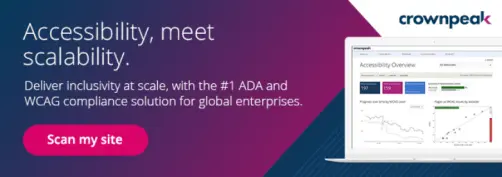ADA Lawsuits Surge: Expert Insights on What the Data Reveals

Does the 2021 spike in ADA lawsuits have your business on the edge of its seat? We recently sat down with William Littman, Crownpeak’s Head of Legal Affairs to discuss the trend and what it means for organizations today.
Last year, there was a slight decrease in the number of lawsuits being filed: 10,982 in 2020 from 11,053 in 2019, to be exact. However, this is still a bit surprising given how much of 2020 was wrapped around a global pandemic.
But now, in January 2021 alone, a total of 1,108 cases have been filed — the most ever in a single month. That’s more than 10% of the total number of lawsuits filed in all of 2020, which means that 2021 is already on track to become a record-breaking year .
4 key insights from ADA lawsuit trends
What can companies learn from this recent rise in website accessibility lawsuits?
Here’s what the data can — and can’t — reveal:
1. The number of lawsuits only tells part of the story
Tracking the number of lawsuits filed in 2020 month by month, you can see a fairly predictable pattern. Total cases dropped significantly in April and May — the early months of the global pandemic that brought normal working conditions and daily life to a grinding halt.
Trends like these may be easily accounted for, especially with the effects of 2020 still fresh in our minds. However, not all stories behind the data are quite so obvious.
For example, more than 265,000 ADA demand letters were sent to U.S. businesses in 2020, and yet only 10,892 lawsuits were filed. This reveals three things:
First, not all ADA demand letters become full-fledged lawsuits.
Second, because not all issues become lawsuits, many important accessibility-related issues are not reflected in the data.
Third, because not all relevant issues are reflected in the data, many businesses could be missing opportunities to learn from others’ mistakes and improve their own experiences.
What we’ve found is that ADA demand letter issues that are resolved in a timely manner may never become official lawsuits. This level of proactivity is excellent for users and businesses alike because it results in an optimal user experience. The downside is that it can skew the data simply by not telling the full picture of accessible website issues.
2. The spike in lawsuits underscores the importance of digital experiences
Though things like digital shopping, remote work, and online communications are nothing new, the 2020 pandemic gave these channels new importance. In an effort to maintain social distancing at school, in the workplace, and going about everyday business, people were increasingly reliant on the internet.
According to Pew Research Center , 53% of respondents described the internet as being “essential” during the pandemic. Online shopping soared and screen time guidelines have been reconsidered.
This could help to explain why the majority of ADA lawsuits filed last year centered around consumer goods. According to Accessibility.com , the Consumer Goods category held the #1 spot for website accessibility lawsuits for seven straight months, with Apparel also ranking in the top 5 during this time.
As more people depend on digital channels for everyday needs, including work, education, shopping, and even grocery shopping, it’s more important than ever for businesses to provide an equitable experience.
3. Website accessibility lawsuits are increasingly affecting more industries

Littman noted another trend revealed by lawsuit data: more industries are being affected by ADA Title III requirements.
“In the past, a common assumption was that only digital properties with associated ‘brick and mortar’ retail locations needed to provide inclusive online experiences, while those without physical locations were generally thought to be immune from web accessibility litigation. Recent legal cases have begun to change the narrative and we are now watching more and more digital-only businesses involved in accessibility focused litigation,” explains Littman. “The takeaway here is that while all places of business, both physical anddigital, should be accessible to all users, legal precedence appears to suggest more and more that the ‘brick and mortar’ argument no longer carries the weight that it once did when used as a legal defense.”
In February 2021, Accessibility.com revealed that the media industry was among the top 5 targeted industries of ADA-related lawsuits for the first time in history. Littman cited services like Spotify and Netflix “have not been codified into ADA, but they have been read into ADA by courts and the Department of Justice."
Purely information sites, such as Wikipedia.org, where there’s no money exchanged and no goods or services being sold might also be a target for ADA lawsuits.
“The most winnable or arguable cases are going to be those involving the exchange of goods and services, but we’ve seen a trend where informational websites are being called into question,” explains Littman. “There’s really no industry or vertical limitation we’re seeing with the lawsuits coming across our desks today.”
Littman also mentions that the recent ADA lawsuit trends are going above and beyond website accessibility issues. Mobile apps, software, and intranet are also becoming hot topics in legal circles. “Everything digital is being looked at from an accessibility standpoint.”
Littman shares the companies being targeted aren’t just big businesses, either. Lots of smaller companies and service providers are being expected to provide inclusive website experiences.
4. The biggest takeaway for organizations
Making websites accessible to every user is the right thing to do. It’s not just about avoiding lawsuits or addressing ADA demand letters.
Littman believes that businesses should understand the stories behind the data to help guide their decisions for improvement.
"A lot of the legal is very dry and is just a recitation of the numbers,” he explains. “But what’s more important is realizing that we're dealing with real people and real issues related to accessibility. These are people who need to have access to your website, and accessibility is a feature that companies should adopt as a matter of course. There’s really a lot more going on under the surface of the data that’s published, and every business needs to remember that this is more than just trends and numbers. At the end of the day, it's about people.”
To learn more about how Crownpeak can help you accelerate your digital accessibility goals, and simplify the formation and execution of best-in-class digital governance programs, speak to an expert today , or request a complimentary Web Accessibility Assessment .
